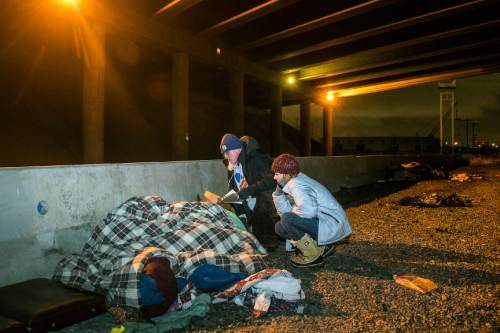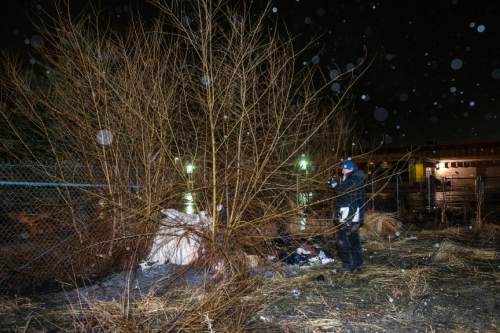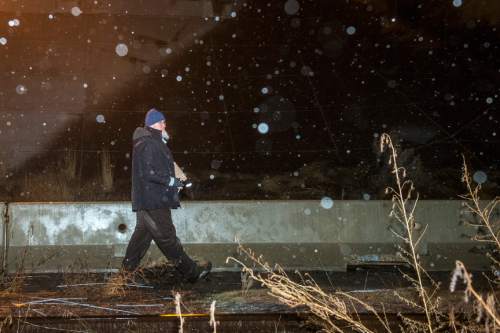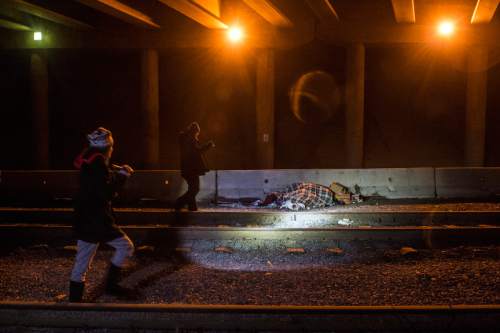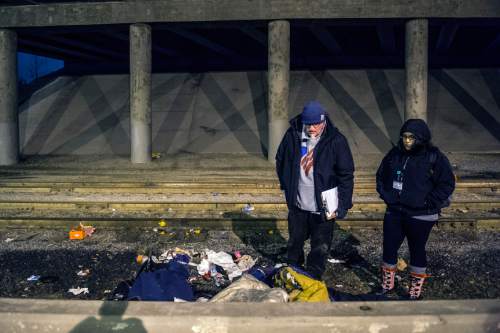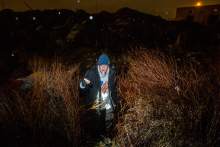This is an archived article that was published on sltrib.com in 2016, and information in the article may be outdated. It is provided only for personal research purposes and may not be reprinted.
Saturday morning at 4:30 an outreach team from Utah's Volunteers of America marched along a railroad siding in an industrial area as rain turned to snow. Where the tracks run beneath a freeway overpass, they came upon a big lump of blankets and a cardboard box containing a mishmash of packaged food.
"Good morning, VOA," announced Larry Mullin, a caseworker for the organization.
There was murmuring from beneath the blankets and after a while a face appeared. Mullin knelt down to discover there were actually two people there — a man and a woman. They took some hand-warmers from the team and asked for water.
Every January, VOA scours Salt Lake City and the surrounding area for homeless people as part of the national "Point in Time" count, a funding requirement of the U.S. Department of Housing and Urban Development.
A census is taken of people at shelters, but VOA staffers and volunteers also bundle up and coffee up for the effort from about 4 a.m. to 7 a.m. across three days that attempts a headcount before the homeless begin moving around. They find folks camped out under viaducts, alongside railroad spurs, in culverts and behind warehouses.
Among the 100 volunteers at this year's effort was Madison Takos, 26, from South Weber. "We want to make sure people aren't invisible," she said. "We want to see how we can better serve them."
The Point in Time count also gives volunteers a better awareness of homelessness, said outreach worker Jessica Marcev.
"It enables the community to get involved and see [a fuller] picture of homelessness in our community," she said.
The woman under the blankets alongside the railroad tracks agreed to answer questions as Mullin read them from a form on his clipboard.
She is 28 years old and is pregnant. She's been homeless off and on for the past 10 years. Last year, she was in Oregon and she's with a male companion. The woman said she is getting prenatal care at the Fourth Street Clinic.
Later, Mullin explained that the woman may have mental health issues.
"She shied away from questions about physical or sexual abuse," he said. "Clearly there is some trauma."
About 100 feet down the tracks, the team found another pile of blankets.
"Good morning, VOA," Mullin called out.
A man's angry voice bellowed out of the heap, warning the team to stay away.
As they continued along the tracks beyond the overpass, a wet snow was falling hard. A homeless man coming the opposite way stopped for a short chat and then moved quickly along.
"He's tweaking," Mullin explained. "High on meth."
Mental illness and substance abuse are not uncommon among the homeless population that camps out year round, said outreach worker Kelley Irmen. They face many hurdles in their day-to-day lives and for some of them, finding a home is almost impossible."
It can happen, however, if they get treatment and get sober, she said. But they need a lot of help.
On the way back to the car, Mullin and Irmen exchange notes with another member of the team who had stayed with the pregnant woman. After some discussion the woman had agreed to go with outreach workers Monday to the VOA's storefront near 500 West and 700 South. There, she can get a shower and wash her clothes.
It also will give VOA workers an opportunity to make sure she goes to the Fourth Street Clinic for prenatal care.
The pregnant woman would qualify for housing under Utah's program to eliminate chronic homelessness, said VOA spokeswoman DeAnn Zebelean. But for one reason or another that has not happened. Among the challenges for VOA and other outreach workers is guiding those people, when they are ready, through the system that could provide them housing.
In 2005, there were an estimated 1,932 chronic homeless people in Utah, according to the definition of being homeless for more than one year or being homeless three times over several years. The number of the chronic homeless here has been cut by some 90 percent over the past decade.
But there remain about 13,500 people without homes in this state who don't meet that definition.


